Health Inequalities: Examining Causes, Effects, and Solutions
VerifiedAdded on 2020/03/16
|9
|2159
|106
Report
AI Summary
This report delves into the multifaceted issue of health inequalities, examining the disparities in health outcomes across different socio-economic classes. It highlights the correlation between wealth and health, illustrating how affluent populations often experience better health and longer lifespans compared to their less fortunate counterparts. The report explores various factors contributing to these inequalities, including malnutrition, obesity, and unequal access to healthcare facilities. Furthermore, it addresses the concept of plagiarism in academic writing, offering strategies to avoid it through paraphrasing, quoting, and summarizing. Finally, the report discusses different citation styles, emphasizing their importance in giving credit to authors and providing credibility to research. It covers various citation formats such as Harvard, APA, and MLA, which are used to support the students' ideas by referring to strong sources.
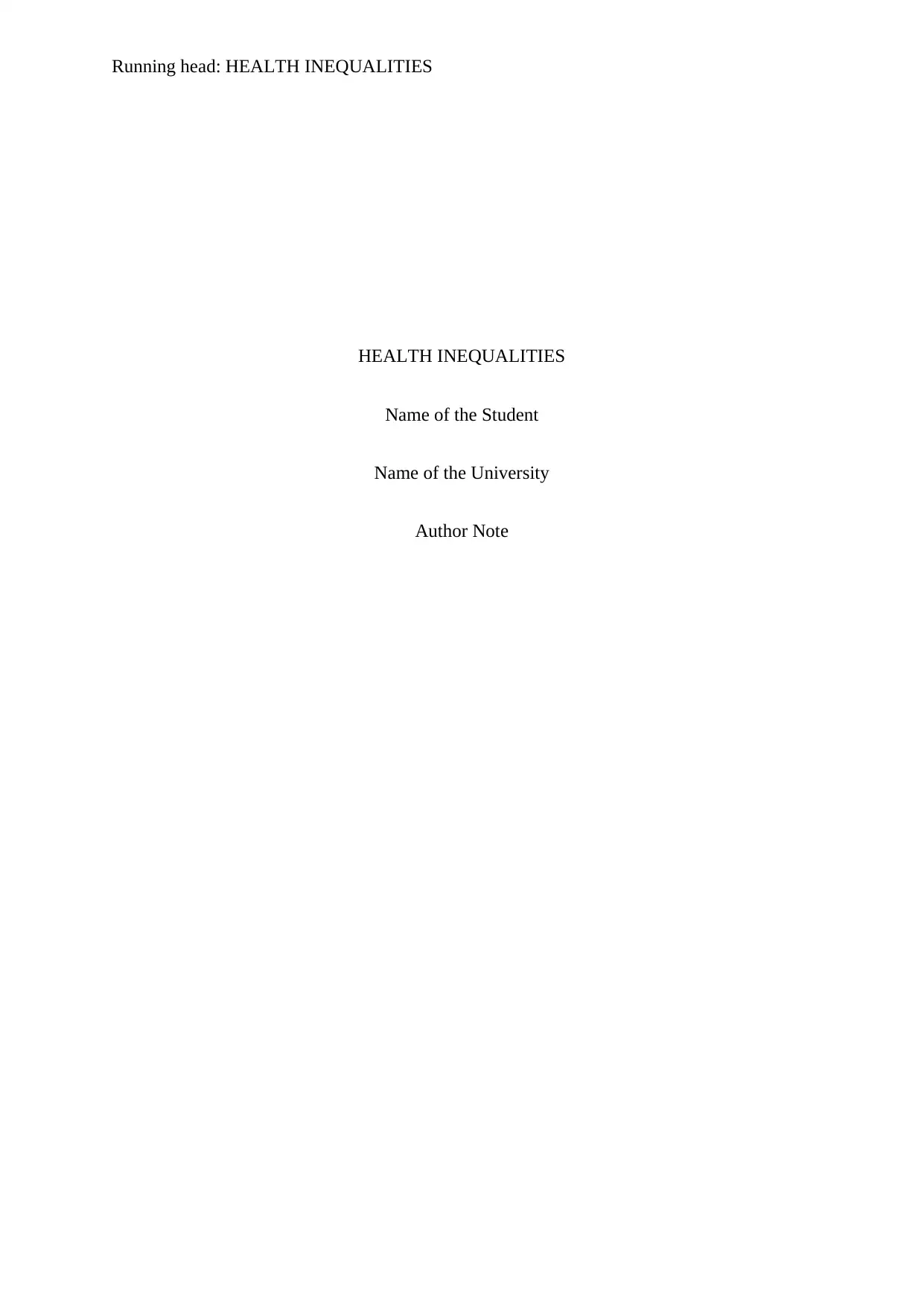
Running head: HEALTH INEQUALITIES
HEALTH INEQUALITIES
Name of the Student
Name of the University
Author Note
HEALTH INEQUALITIES
Name of the Student
Name of the University
Author Note
Paraphrase This Document
Need a fresh take? Get an instant paraphrase of this document with our AI Paraphraser
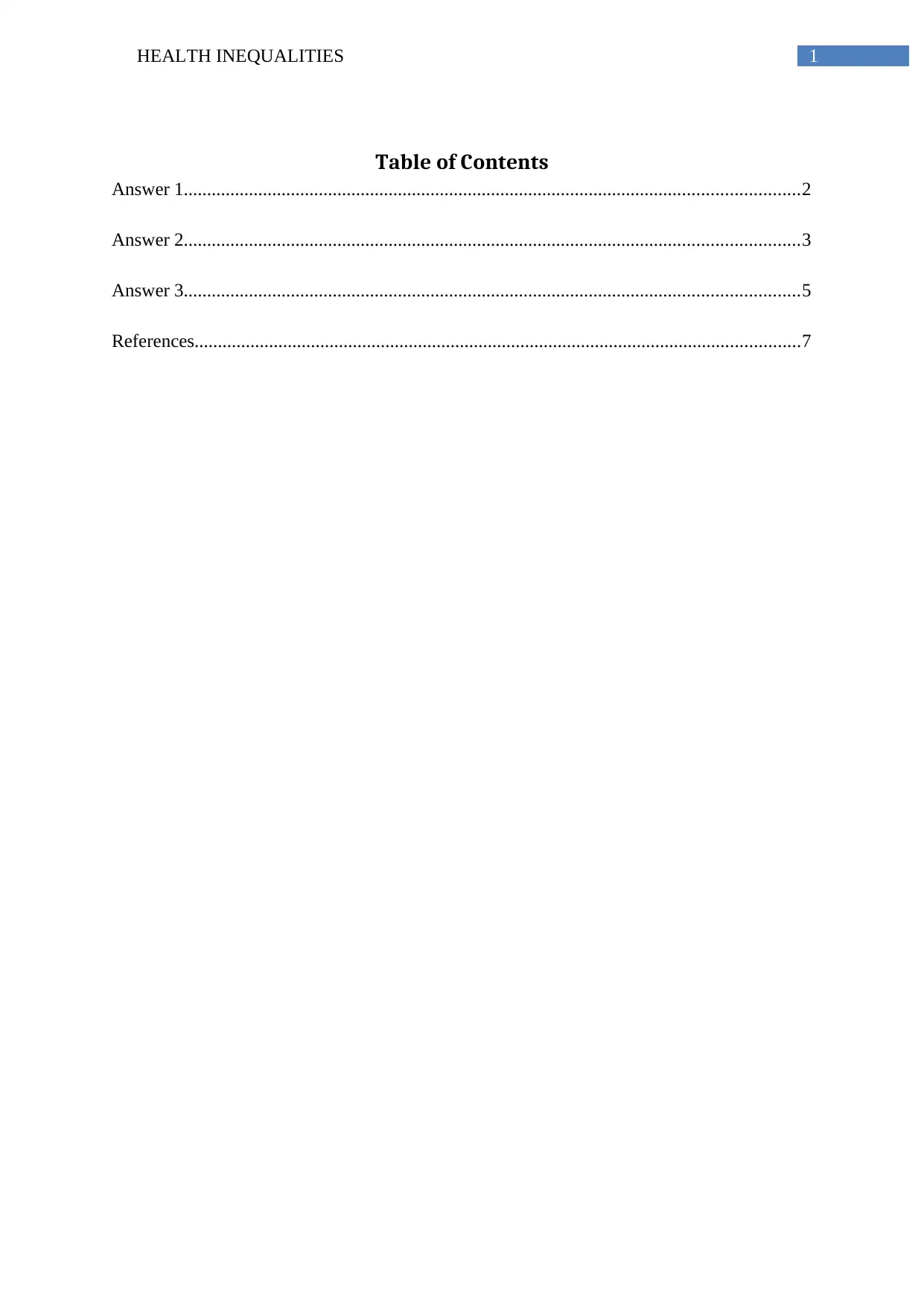
1HEALTH INEQUALITIES
Table of Contents
Answer 1....................................................................................................................................2
Answer 2....................................................................................................................................3
Answer 3....................................................................................................................................5
References..................................................................................................................................7
Table of Contents
Answer 1....................................................................................................................................2
Answer 2....................................................................................................................................3
Answer 3....................................................................................................................................5
References..................................................................................................................................7
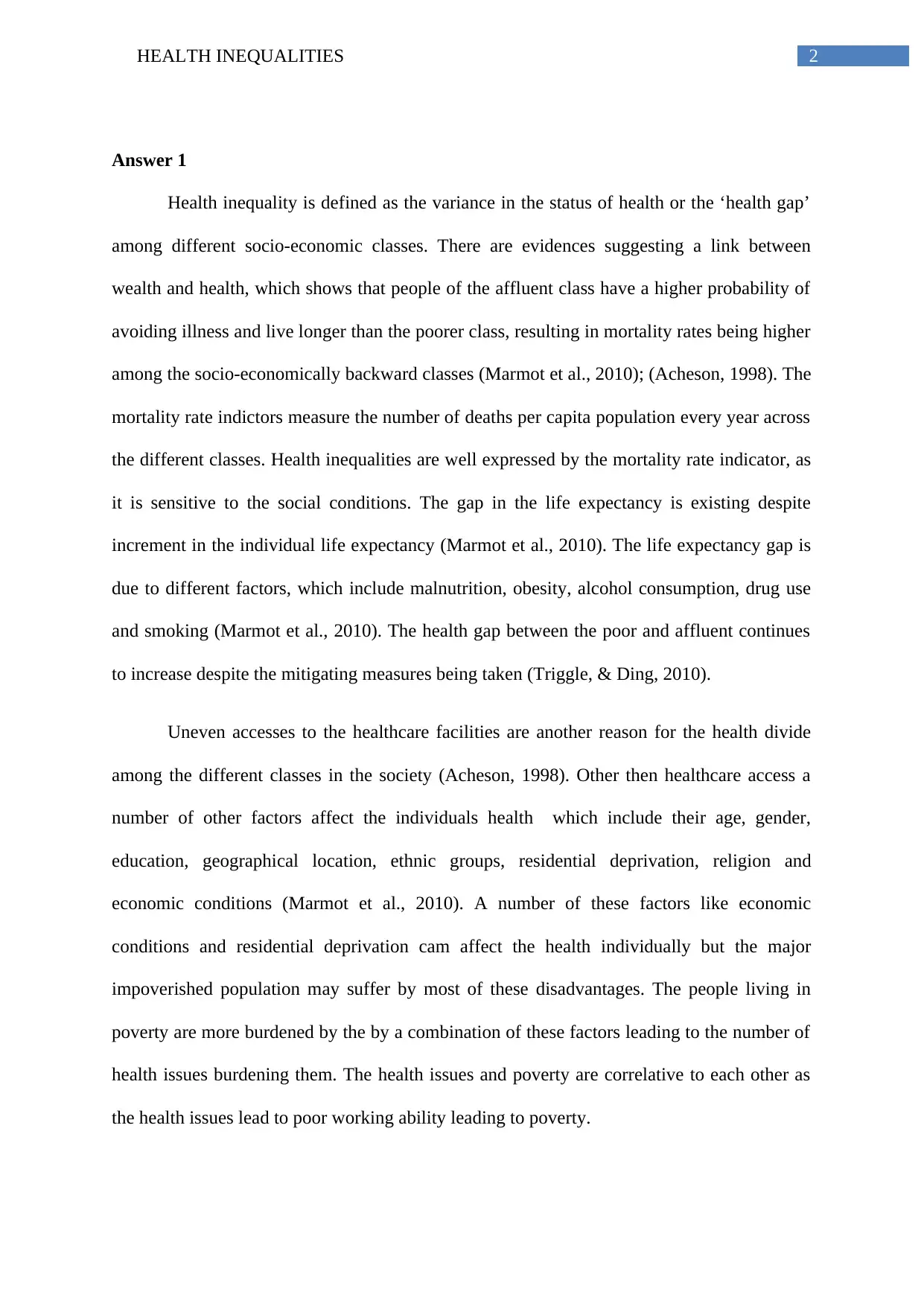
2HEALTH INEQUALITIES
Answer 1
Health inequality is defined as the variance in the status of health or the ‘health gap’
among different socio-economic classes. There are evidences suggesting a link between
wealth and health, which shows that people of the affluent class have a higher probability of
avoiding illness and live longer than the poorer class, resulting in mortality rates being higher
among the socio-economically backward classes (Marmot et al., 2010); (Acheson, 1998). The
mortality rate indictors measure the number of deaths per capita population every year across
the different classes. Health inequalities are well expressed by the mortality rate indicator, as
it is sensitive to the social conditions. The gap in the life expectancy is existing despite
increment in the individual life expectancy (Marmot et al., 2010). The life expectancy gap is
due to different factors, which include malnutrition, obesity, alcohol consumption, drug use
and smoking (Marmot et al., 2010). The health gap between the poor and affluent continues
to increase despite the mitigating measures being taken (Triggle, & Ding, 2010).
Uneven accesses to the healthcare facilities are another reason for the health divide
among the different classes in the society (Acheson, 1998). Other then healthcare access a
number of other factors affect the individuals health which include their age, gender,
education, geographical location, ethnic groups, residential deprivation, religion and
economic conditions (Marmot et al., 2010). A number of these factors like economic
conditions and residential deprivation cam affect the health individually but the major
impoverished population may suffer by most of these disadvantages. The people living in
poverty are more burdened by the by a combination of these factors leading to the number of
health issues burdening them. The health issues and poverty are correlative to each other as
the health issues lead to poor working ability leading to poverty.
Answer 1
Health inequality is defined as the variance in the status of health or the ‘health gap’
among different socio-economic classes. There are evidences suggesting a link between
wealth and health, which shows that people of the affluent class have a higher probability of
avoiding illness and live longer than the poorer class, resulting in mortality rates being higher
among the socio-economically backward classes (Marmot et al., 2010); (Acheson, 1998). The
mortality rate indictors measure the number of deaths per capita population every year across
the different classes. Health inequalities are well expressed by the mortality rate indicator, as
it is sensitive to the social conditions. The gap in the life expectancy is existing despite
increment in the individual life expectancy (Marmot et al., 2010). The life expectancy gap is
due to different factors, which include malnutrition, obesity, alcohol consumption, drug use
and smoking (Marmot et al., 2010). The health gap between the poor and affluent continues
to increase despite the mitigating measures being taken (Triggle, & Ding, 2010).
Uneven accesses to the healthcare facilities are another reason for the health divide
among the different classes in the society (Acheson, 1998). Other then healthcare access a
number of other factors affect the individuals health which include their age, gender,
education, geographical location, ethnic groups, residential deprivation, religion and
economic conditions (Marmot et al., 2010). A number of these factors like economic
conditions and residential deprivation cam affect the health individually but the major
impoverished population may suffer by most of these disadvantages. The people living in
poverty are more burdened by the by a combination of these factors leading to the number of
health issues burdening them. The health issues and poverty are correlative to each other as
the health issues lead to poor working ability leading to poverty.
⊘ This is a preview!⊘
Do you want full access?
Subscribe today to unlock all pages.

Trusted by 1+ million students worldwide
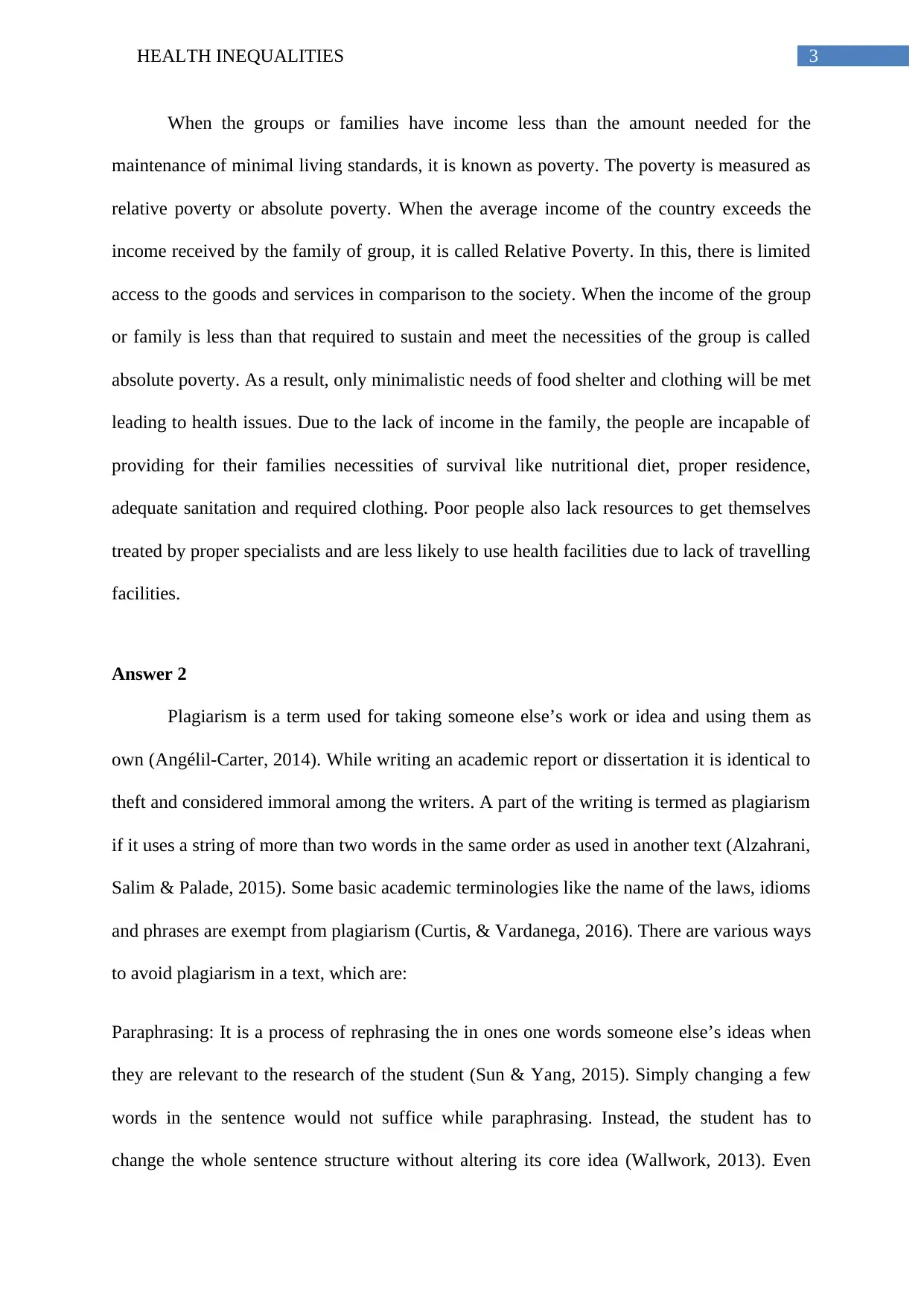
3HEALTH INEQUALITIES
When the groups or families have income less than the amount needed for the
maintenance of minimal living standards, it is known as poverty. The poverty is measured as
relative poverty or absolute poverty. When the average income of the country exceeds the
income received by the family of group, it is called Relative Poverty. In this, there is limited
access to the goods and services in comparison to the society. When the income of the group
or family is less than that required to sustain and meet the necessities of the group is called
absolute poverty. As a result, only minimalistic needs of food shelter and clothing will be met
leading to health issues. Due to the lack of income in the family, the people are incapable of
providing for their families necessities of survival like nutritional diet, proper residence,
adequate sanitation and required clothing. Poor people also lack resources to get themselves
treated by proper specialists and are less likely to use health facilities due to lack of travelling
facilities.
Answer 2
Plagiarism is a term used for taking someone else’s work or idea and using them as
own (Angélil-Carter, 2014). While writing an academic report or dissertation it is identical to
theft and considered immoral among the writers. A part of the writing is termed as plagiarism
if it uses a string of more than two words in the same order as used in another text (Alzahrani,
Salim & Palade, 2015). Some basic academic terminologies like the name of the laws, idioms
and phrases are exempt from plagiarism (Curtis, & Vardanega, 2016). There are various ways
to avoid plagiarism in a text, which are:
Paraphrasing: It is a process of rephrasing the in ones one words someone else’s ideas when
they are relevant to the research of the student (Sun & Yang, 2015). Simply changing a few
words in the sentence would not suffice while paraphrasing. Instead, the student has to
change the whole sentence structure without altering its core idea (Wallwork, 2013). Even
When the groups or families have income less than the amount needed for the
maintenance of minimal living standards, it is known as poverty. The poverty is measured as
relative poverty or absolute poverty. When the average income of the country exceeds the
income received by the family of group, it is called Relative Poverty. In this, there is limited
access to the goods and services in comparison to the society. When the income of the group
or family is less than that required to sustain and meet the necessities of the group is called
absolute poverty. As a result, only minimalistic needs of food shelter and clothing will be met
leading to health issues. Due to the lack of income in the family, the people are incapable of
providing for their families necessities of survival like nutritional diet, proper residence,
adequate sanitation and required clothing. Poor people also lack resources to get themselves
treated by proper specialists and are less likely to use health facilities due to lack of travelling
facilities.
Answer 2
Plagiarism is a term used for taking someone else’s work or idea and using them as
own (Angélil-Carter, 2014). While writing an academic report or dissertation it is identical to
theft and considered immoral among the writers. A part of the writing is termed as plagiarism
if it uses a string of more than two words in the same order as used in another text (Alzahrani,
Salim & Palade, 2015). Some basic academic terminologies like the name of the laws, idioms
and phrases are exempt from plagiarism (Curtis, & Vardanega, 2016). There are various ways
to avoid plagiarism in a text, which are:
Paraphrasing: It is a process of rephrasing the in ones one words someone else’s ideas when
they are relevant to the research of the student (Sun & Yang, 2015). Simply changing a few
words in the sentence would not suffice while paraphrasing. Instead, the student has to
change the whole sentence structure without altering its core idea (Wallwork, 2013). Even
Paraphrase This Document
Need a fresh take? Get an instant paraphrase of this document with our AI Paraphraser
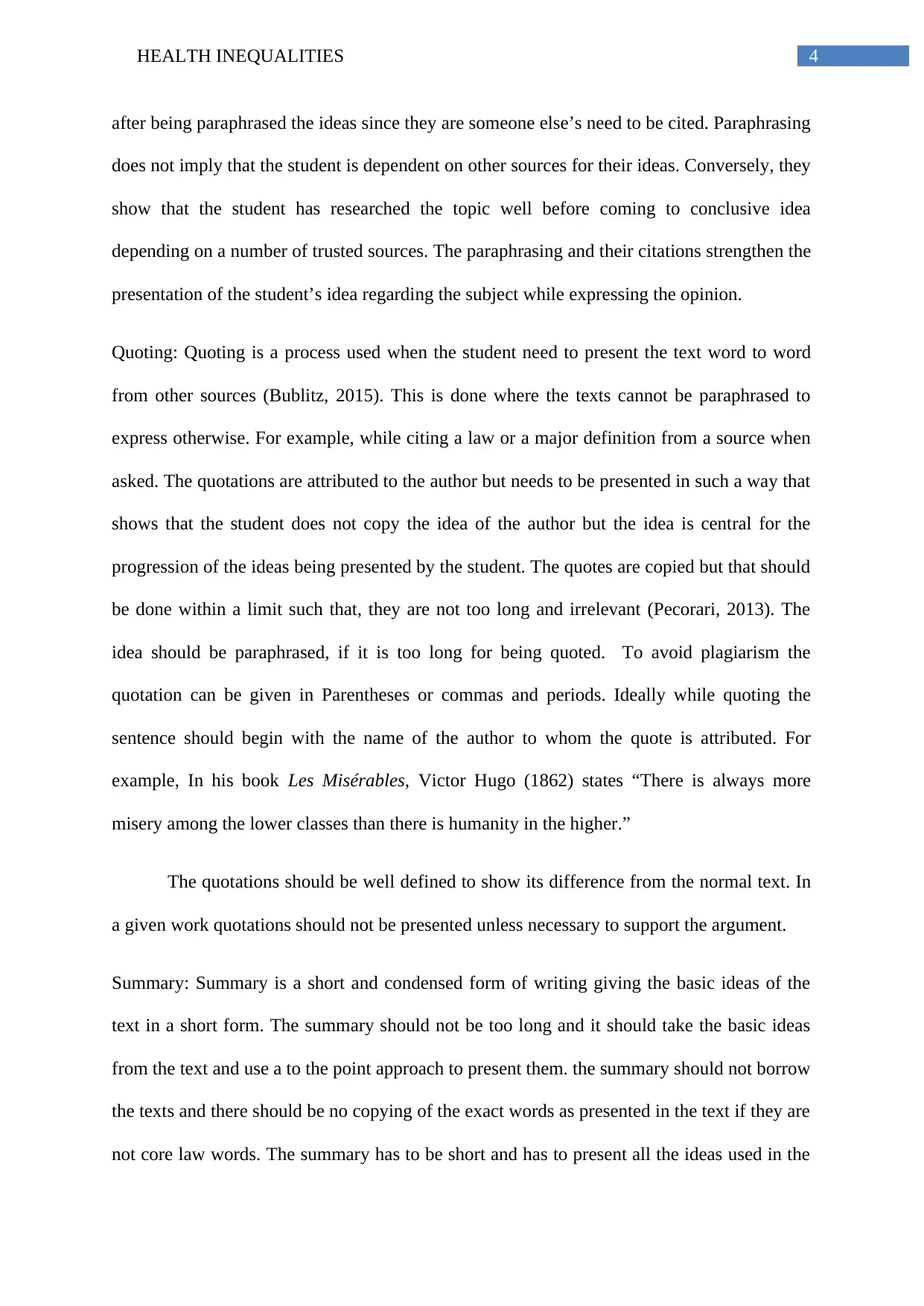
4HEALTH INEQUALITIES
after being paraphrased the ideas since they are someone else’s need to be cited. Paraphrasing
does not imply that the student is dependent on other sources for their ideas. Conversely, they
show that the student has researched the topic well before coming to conclusive idea
depending on a number of trusted sources. The paraphrasing and their citations strengthen the
presentation of the student’s idea regarding the subject while expressing the opinion.
Quoting: Quoting is a process used when the student need to present the text word to word
from other sources (Bublitz, 2015). This is done where the texts cannot be paraphrased to
express otherwise. For example, while citing a law or a major definition from a source when
asked. The quotations are attributed to the author but needs to be presented in such a way that
shows that the student does not copy the idea of the author but the idea is central for the
progression of the ideas being presented by the student. The quotes are copied but that should
be done within a limit such that, they are not too long and irrelevant (Pecorari, 2013). The
idea should be paraphrased, if it is too long for being quoted. To avoid plagiarism the
quotation can be given in Parentheses or commas and periods. Ideally while quoting the
sentence should begin with the name of the author to whom the quote is attributed. For
example, In his book Les Misérables, Victor Hugo (1862) states “There is always more
misery among the lower classes than there is humanity in the higher.”
The quotations should be well defined to show its difference from the normal text. In
a given work quotations should not be presented unless necessary to support the argument.
Summary: Summary is a short and condensed form of writing giving the basic ideas of the
text in a short form. The summary should not be too long and it should take the basic ideas
from the text and use a to the point approach to present them. the summary should not borrow
the texts and there should be no copying of the exact words as presented in the text if they are
not core law words. The summary has to be short and has to present all the ideas used in the
after being paraphrased the ideas since they are someone else’s need to be cited. Paraphrasing
does not imply that the student is dependent on other sources for their ideas. Conversely, they
show that the student has researched the topic well before coming to conclusive idea
depending on a number of trusted sources. The paraphrasing and their citations strengthen the
presentation of the student’s idea regarding the subject while expressing the opinion.
Quoting: Quoting is a process used when the student need to present the text word to word
from other sources (Bublitz, 2015). This is done where the texts cannot be paraphrased to
express otherwise. For example, while citing a law or a major definition from a source when
asked. The quotations are attributed to the author but needs to be presented in such a way that
shows that the student does not copy the idea of the author but the idea is central for the
progression of the ideas being presented by the student. The quotes are copied but that should
be done within a limit such that, they are not too long and irrelevant (Pecorari, 2013). The
idea should be paraphrased, if it is too long for being quoted. To avoid plagiarism the
quotation can be given in Parentheses or commas and periods. Ideally while quoting the
sentence should begin with the name of the author to whom the quote is attributed. For
example, In his book Les Misérables, Victor Hugo (1862) states “There is always more
misery among the lower classes than there is humanity in the higher.”
The quotations should be well defined to show its difference from the normal text. In
a given work quotations should not be presented unless necessary to support the argument.
Summary: Summary is a short and condensed form of writing giving the basic ideas of the
text in a short form. The summary should not be too long and it should take the basic ideas
from the text and use a to the point approach to present them. the summary should not borrow
the texts and there should be no copying of the exact words as presented in the text if they are
not core law words. The summary has to be short and has to present all the ideas used in the
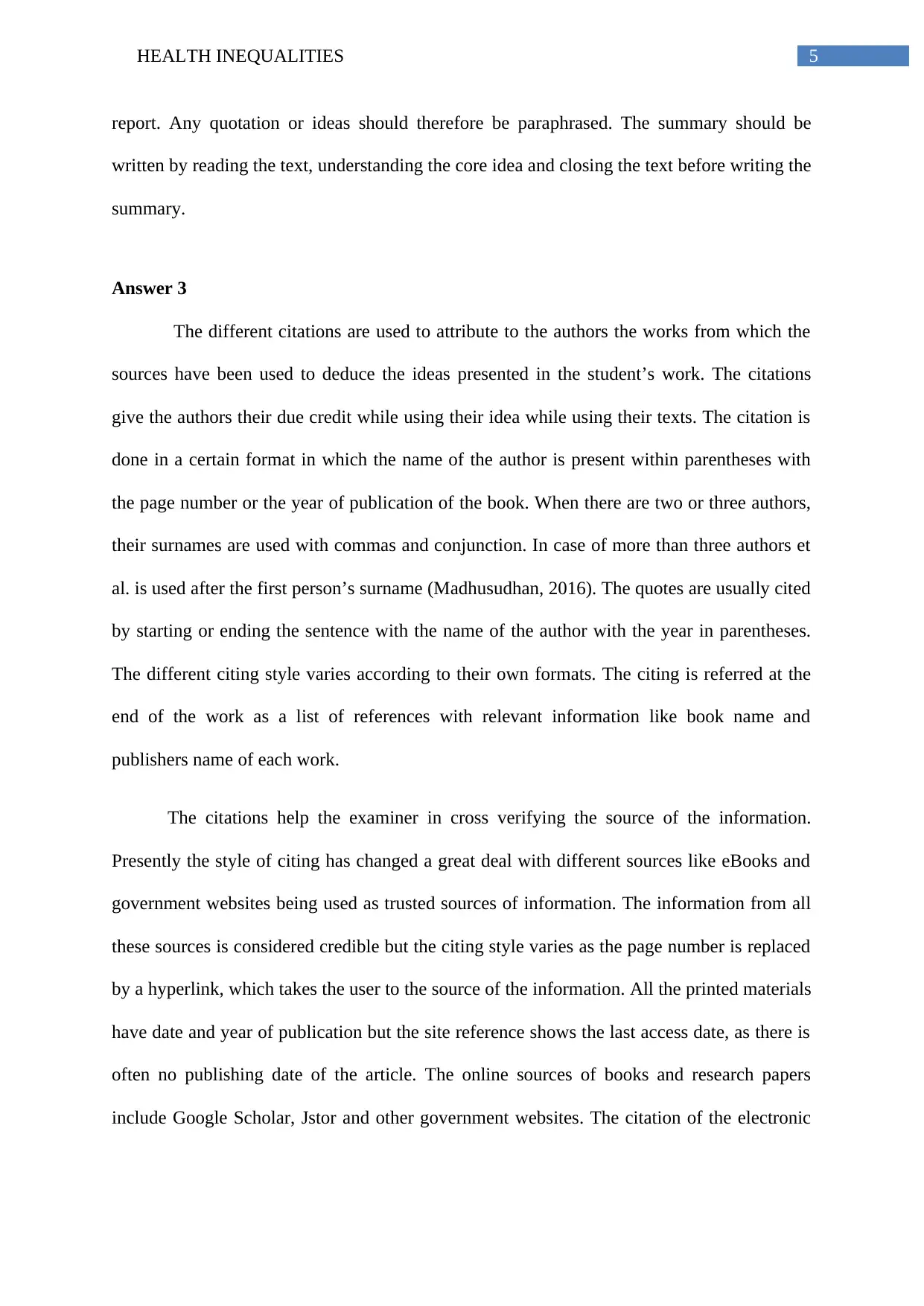
5HEALTH INEQUALITIES
report. Any quotation or ideas should therefore be paraphrased. The summary should be
written by reading the text, understanding the core idea and closing the text before writing the
summary.
Answer 3
The different citations are used to attribute to the authors the works from which the
sources have been used to deduce the ideas presented in the student’s work. The citations
give the authors their due credit while using their idea while using their texts. The citation is
done in a certain format in which the name of the author is present within parentheses with
the page number or the year of publication of the book. When there are two or three authors,
their surnames are used with commas and conjunction. In case of more than three authors et
al. is used after the first person’s surname (Madhusudhan, 2016). The quotes are usually cited
by starting or ending the sentence with the name of the author with the year in parentheses.
The different citing style varies according to their own formats. The citing is referred at the
end of the work as a list of references with relevant information like book name and
publishers name of each work.
The citations help the examiner in cross verifying the source of the information.
Presently the style of citing has changed a great deal with different sources like eBooks and
government websites being used as trusted sources of information. The information from all
these sources is considered credible but the citing style varies as the page number is replaced
by a hyperlink, which takes the user to the source of the information. All the printed materials
have date and year of publication but the site reference shows the last access date, as there is
often no publishing date of the article. The online sources of books and research papers
include Google Scholar, Jstor and other government websites. The citation of the electronic
report. Any quotation or ideas should therefore be paraphrased. The summary should be
written by reading the text, understanding the core idea and closing the text before writing the
summary.
Answer 3
The different citations are used to attribute to the authors the works from which the
sources have been used to deduce the ideas presented in the student’s work. The citations
give the authors their due credit while using their idea while using their texts. The citation is
done in a certain format in which the name of the author is present within parentheses with
the page number or the year of publication of the book. When there are two or three authors,
their surnames are used with commas and conjunction. In case of more than three authors et
al. is used after the first person’s surname (Madhusudhan, 2016). The quotes are usually cited
by starting or ending the sentence with the name of the author with the year in parentheses.
The different citing style varies according to their own formats. The citing is referred at the
end of the work as a list of references with relevant information like book name and
publishers name of each work.
The citations help the examiner in cross verifying the source of the information.
Presently the style of citing has changed a great deal with different sources like eBooks and
government websites being used as trusted sources of information. The information from all
these sources is considered credible but the citing style varies as the page number is replaced
by a hyperlink, which takes the user to the source of the information. All the printed materials
have date and year of publication but the site reference shows the last access date, as there is
often no publishing date of the article. The online sources of books and research papers
include Google Scholar, Jstor and other government websites. The citation of the electronic
⊘ This is a preview!⊘
Do you want full access?
Subscribe today to unlock all pages.

Trusted by 1+ million students worldwide
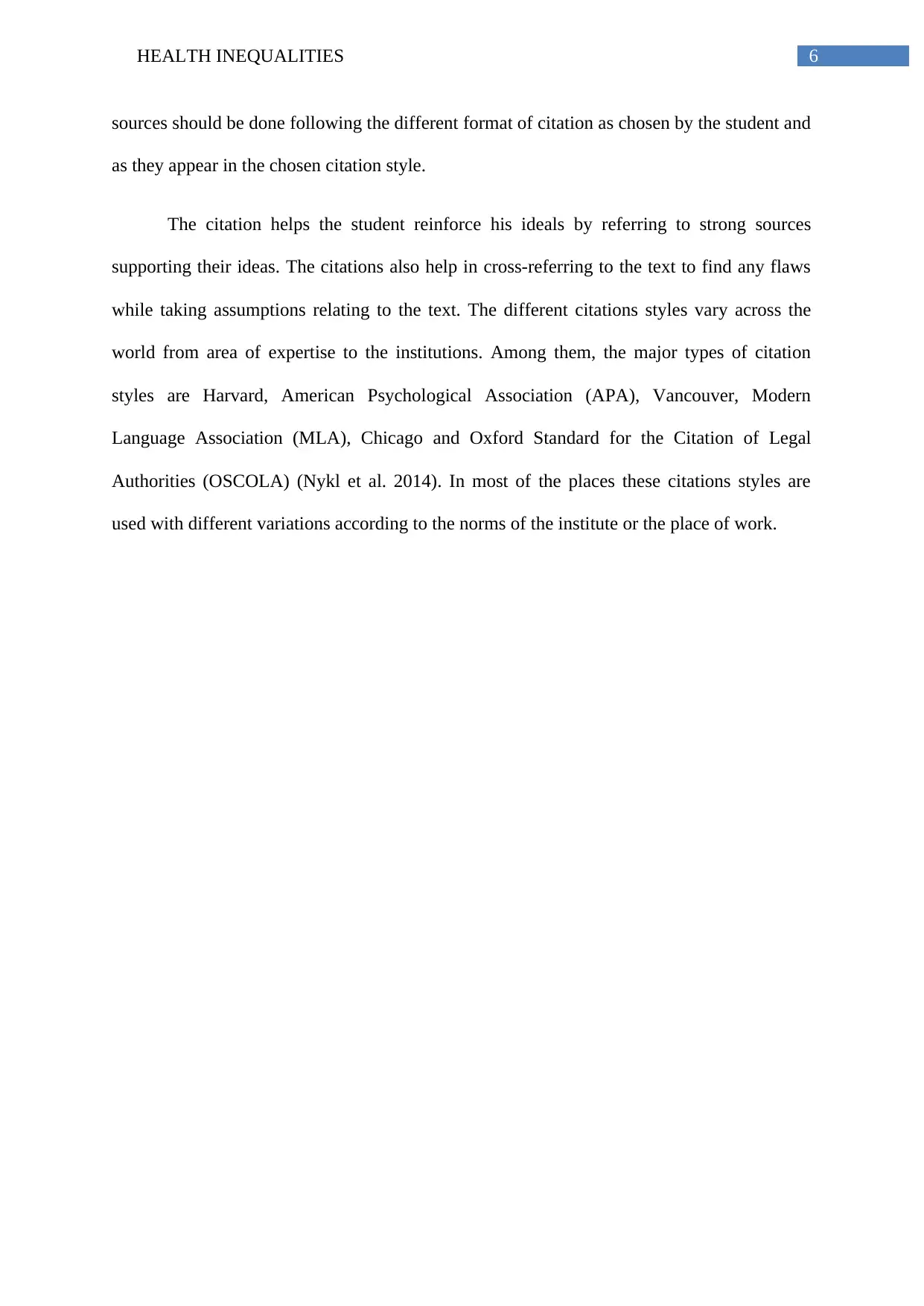
6HEALTH INEQUALITIES
sources should be done following the different format of citation as chosen by the student and
as they appear in the chosen citation style.
The citation helps the student reinforce his ideals by referring to strong sources
supporting their ideas. The citations also help in cross-referring to the text to find any flaws
while taking assumptions relating to the text. The different citations styles vary across the
world from area of expertise to the institutions. Among them, the major types of citation
styles are Harvard, American Psychological Association (APA), Vancouver, Modern
Language Association (MLA), Chicago and Oxford Standard for the Citation of Legal
Authorities (OSCOLA) (Nykl et al. 2014). In most of the places these citations styles are
used with different variations according to the norms of the institute or the place of work.
sources should be done following the different format of citation as chosen by the student and
as they appear in the chosen citation style.
The citation helps the student reinforce his ideals by referring to strong sources
supporting their ideas. The citations also help in cross-referring to the text to find any flaws
while taking assumptions relating to the text. The different citations styles vary across the
world from area of expertise to the institutions. Among them, the major types of citation
styles are Harvard, American Psychological Association (APA), Vancouver, Modern
Language Association (MLA), Chicago and Oxford Standard for the Citation of Legal
Authorities (OSCOLA) (Nykl et al. 2014). In most of the places these citations styles are
used with different variations according to the norms of the institute or the place of work.
Paraphrase This Document
Need a fresh take? Get an instant paraphrase of this document with our AI Paraphraser

7HEALTH INEQUALITIES
References
Acheson, D. (1998). Inequalities in health: Report on inequalities in health did give priority
for steps to be tackled. BMJ: British Medical Journal, 317(7173), 1659.
Alzahrani, S. M., Salim, N., & Palade, V. (2015). Uncovering highly obfuscated plagiarism
cases using fuzzy semantic-based similarity model. Journal of King Saud University-
Computer and Information Sciences, 27(3), 248-268.
Angélil-Carter, S. (2014). Stolen language?: Plagiarism in writing. Routledge.
Bailey, S. (2014). Academic writing: A handbook for international students. Routledge.
Bublitz, W. (2015). Introducing Quoting as a Ubiquitous Meta-communicative Act. The
Pragmatics of Quoting Now and Then, 89, 1.
Curtis, G. J., & Vardanega, L. (2016). Is plagiarism changing over time? A 10-year time-lag
study with three points of measurement. Higher Education Research & Development,
35(6), 1167-1179.
Madhusudhan, M. (2016). Use of Online Citation Tools by Students and Research Scholars
of Department of Library and Information Science, University of Delhi. DESIDOC
Journal of Library & Information Technology, 36(3).
Marmot, M., Allen, J., Goldblatt, P., Boyce, T., McNeish, D., Grady, M., & Geddes, I.
(2010). The Marmot review: Fair society, healthy lives. The Strategic Review of
Health Inequalities in England Post-2010.
Nykl, M., Ježek, K., Fiala, D., & Dostal, M. (2014). PageRank variants in the evaluation of
citation networks. Journal of Informetrics, 8(3), 683-692.
References
Acheson, D. (1998). Inequalities in health: Report on inequalities in health did give priority
for steps to be tackled. BMJ: British Medical Journal, 317(7173), 1659.
Alzahrani, S. M., Salim, N., & Palade, V. (2015). Uncovering highly obfuscated plagiarism
cases using fuzzy semantic-based similarity model. Journal of King Saud University-
Computer and Information Sciences, 27(3), 248-268.
Angélil-Carter, S. (2014). Stolen language?: Plagiarism in writing. Routledge.
Bailey, S. (2014). Academic writing: A handbook for international students. Routledge.
Bublitz, W. (2015). Introducing Quoting as a Ubiquitous Meta-communicative Act. The
Pragmatics of Quoting Now and Then, 89, 1.
Curtis, G. J., & Vardanega, L. (2016). Is plagiarism changing over time? A 10-year time-lag
study with three points of measurement. Higher Education Research & Development,
35(6), 1167-1179.
Madhusudhan, M. (2016). Use of Online Citation Tools by Students and Research Scholars
of Department of Library and Information Science, University of Delhi. DESIDOC
Journal of Library & Information Technology, 36(3).
Marmot, M., Allen, J., Goldblatt, P., Boyce, T., McNeish, D., Grady, M., & Geddes, I.
(2010). The Marmot review: Fair society, healthy lives. The Strategic Review of
Health Inequalities in England Post-2010.
Nykl, M., Ježek, K., Fiala, D., & Dostal, M. (2014). PageRank variants in the evaluation of
citation networks. Journal of Informetrics, 8(3), 683-692.

8HEALTH INEQUALITIES
Pecorari, D. (2013). Teaching to avoid plagiarism: How to promote good source use.
McGraw-Hill Education (UK).
Sun, Y. C., & Yang, F. Y. (2015). Uncovering published authors' text-borrowing practices:
Paraphrasing strategies, sources, and self-plagiarism. Journal of English for Academic
Purposes, 20, 224-236.
Triggle, C. R., & Ding, H. (2010). A review of endothelial dysfunction in diabetes: a focus on
the contribution of a dysfunctional eNOS. Journal of the American Society of
Hypertension, 4(3), 102-115.
Wallwork, A. (2013). Paraphrasing and avoiding plagiarism. In English for Academic
Research: Writing Exercises (pp. 117-138). Springer US.
Pecorari, D. (2013). Teaching to avoid plagiarism: How to promote good source use.
McGraw-Hill Education (UK).
Sun, Y. C., & Yang, F. Y. (2015). Uncovering published authors' text-borrowing practices:
Paraphrasing strategies, sources, and self-plagiarism. Journal of English for Academic
Purposes, 20, 224-236.
Triggle, C. R., & Ding, H. (2010). A review of endothelial dysfunction in diabetes: a focus on
the contribution of a dysfunctional eNOS. Journal of the American Society of
Hypertension, 4(3), 102-115.
Wallwork, A. (2013). Paraphrasing and avoiding plagiarism. In English for Academic
Research: Writing Exercises (pp. 117-138). Springer US.
⊘ This is a preview!⊘
Do you want full access?
Subscribe today to unlock all pages.

Trusted by 1+ million students worldwide
1 out of 9
Related Documents
Your All-in-One AI-Powered Toolkit for Academic Success.
+13062052269
info@desklib.com
Available 24*7 on WhatsApp / Email
![[object Object]](/_next/static/media/star-bottom.7253800d.svg)
Unlock your academic potential
Copyright © 2020–2025 A2Z Services. All Rights Reserved. Developed and managed by ZUCOL.





